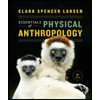ANTH105 Lab 2
pdf
School
Edmonds Community College *
*We aren’t endorsed by this school
Course
222
Subject
Anthropology
Date
Feb 20, 2024
Type
Pages
5
Uploaded by AgentMusic11755
ANTH 105 Human Evolution
Spring 2024
Page 1
of 4
Lab 2: What is a Primate? Total Points: 20 pts.
Name: TA & Section: Part 1: Primate Skeletal Anatomy
Evolutionary relationships can be studied by examining the skeletal morphology of different organisms. Therefore, you should be familiar with basic primate skeletal anatomy. After reviewing the main bones, test your skills by completing this “Label the Skeleton” quiz:
https://www.purposegames.com/game/label-the-skeleton-game
Once you click on the link, zoom out if necessary, so that you can see the entire skeleton, then press the play button in the middle. The instructor was able to finish the quiz in 1:24 with a perfect score. Can you beat the record? But do not worry if you do not get a perfect score or a record time. 1.
Paste a screenshot of your best score here: (6 pts.)
Part 2: Key Traits in Evolution
Taxonomy is the science of naming and classifying biological organisms. The identification of key traits in evolutionary studies allows us to determine which species are closely related.
2.
In your own words, explain the difference between ancestral and derived traits. (1 pt.)
3.
Describe at least one ancestral and one derived trait in primates. (2 pts.)
4.
What is an example of a specialized trait in primates? (1 pt.)
Aya Ghalyon
Kevin Oliver Suemnicht - Wednesday 8am-10am
Ancestral traits are characteristics inherited from a common ancestor, while derived traits are modi
fi
cations that have evolved since the divergence from that ancestor.
An ancestral trait in primates could be fi
ve digits on each limb, while a derived trait could be opposable thumbs.
A specialized trait in primates is the presence of forward-facing eyes, which enhances depth perception and binocular vision.
Screenshot for question number one:
ANTH 105 Human Evolution
Spring 2024
Page 2
of 4
Part 3: The Primate Suite of Traits Modern primates possess a suite of traits that differ from other mammals and reflect the major trends in primate evolution. These include an enclosed postorbital anatomy (bar/plate), trichromacy, large brains, and arboreal adaptations. Using the images provided below, identify the primate traits circled in red. Be as specific as possible with your answers. 5.
Observe the following image of a primate. Based on the primate suite of traits, what is the name of the skeletal trait circled in red? What type of evolutionary trait (ancestral or derived) does this anatomy represent in primates? Be specific with your answers. (1.5 pts)
The red-circled feature, ca
ll
ed the Postorbital Bar, is a special bone structure seen in primates that separates them from other animals. It's part of their sku
ll
and shows how their eyes are enclosed di
ff
erently, which helps them see better in trees. This change happened over a long time as primates adapted to living in forests, making it a unique derived trait in their family tree.
Your preview ends here
Eager to read complete document? Join bartleby learn and gain access to the full version
- Access to all documents
- Unlimited textbook solutions
- 24/7 expert homework help
ANTH 105 Human Evolution
Spring 2024
Page 3
of 4
6.
Observe the following image of a primate. Based on the primate suite of traits, what is the name of the skeletal trait circled in red? Be specific with your answers. (0.5 pts)
The name of the skeletal trait is the opposable thumbs
ANTH 105 Human Evolution
Spring 2024
Page 4
of 4
Part 4: Primate Traits in Action
In this activity, you will observe the primate suite of traits in action. Watch the following videos about living primates and answer the corresponding questions about primate traits.
7.
Watch this video on Spider monkeys:
https://www.youtube.com/watch?v=yqzVI0CSKCU&t=111s
7a. Describe at least two different key primate traits that can be discerned in this video. (2 pts.) 7b. Explain how these traits might benefit spider monkeys. (2 pts.)
8.
Watch this video on Chimpanzees:
https://www.youtube.com/watch?v=BjMhSfxL1sw
8a. Describe at least two different key primate traits that can be discerned in this video. (2 pts.)
8b. Explain how these traits might benefit chimpanzees. (2 pts.)
The video depicts spider monkeys displaying two key primate traits: a prehensile tail, which they use to grasp and manipulate objects, and an apprehensive tail, utilized for communication and emotional expression.
In the case of spider monkeys, the prehensile tail enables them to navigate adeptly through the forest canopy by providing extra support and balance, while the apprehensive tail aids in social communication within the group, facilitating coordination during activities such as foraging and predator detection.
In this video, two key primate traits are evident: complex emotional expression through facial expressions like yawning and laughing, and the ability to learn from each other by observing and imitating behaviors
These traits bene
fi
t chimpanzees by promoting social bonding and communication within their groups. The expression of complex emotions helps in resolving con
fl
icts and fostering group cohesion, while observational learning facilitates the transfer of knowledge and the development of adaptive behaviors, ultimately aiding in their survival and adaptation.
Related Documents
Recommended textbooks for you

Essentials of Physical Anthropology (Third Editio...
Anthropology
ISBN:9780393938661
Author:Clark Spencer Larsen
Publisher:W. W. Norton & Company
Recommended textbooks for you
 Essentials of Physical Anthropology (Third Editio...AnthropologyISBN:9780393938661Author:Clark Spencer LarsenPublisher:W. W. Norton & Company
Essentials of Physical Anthropology (Third Editio...AnthropologyISBN:9780393938661Author:Clark Spencer LarsenPublisher:W. W. Norton & Company

Essentials of Physical Anthropology (Third Editio...
Anthropology
ISBN:9780393938661
Author:Clark Spencer Larsen
Publisher:W. W. Norton & Company